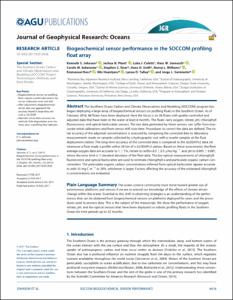Biogeochemical sensor performance in the SOCCOM profiling float array.

View/
Average rating
votes
Date
2017Author
Johnson, Kenneth S.
Plant, Joshua N.
Coletti, Luke J.
Jannasch, Hans W.
Sakamoto, Carole M.
Riser, Stephen C.
Swift, Dana D.
Williams, Nancy L.
Boss, Emmanuel
Haentjens, Nils
Talley, Lynne D.
Sarmiento, Jorge L.
Metadata
Show full item recordAbstract
The Southern Ocean Carbon and Climate Observations and Modeling (SOCCOM) program has
begun deploying a large array of biogeochemical sensors on profiling floats in the Southern Ocean. As of
February 2016, 86 floats have been deployed. Here the focus is on 56 floats with quality-controlled and
adjusted data that have been in the water at least 6 months. The floats carry oxygen, nitrate, pH, chlorophyll
fluorescence, and optical backscatter sensors. The raw data generated by these sensors can suffer from inaccurate
initial calibrations and from sensor drift over time. Procedures to correct the data are defined. The initial
accuracy of the adjusted concentrations is assessed by comparing the corrected data to laboratory
measurements made on samples collected by a hydrographic cast with a rosette sampler at the float
deployment station. The long-term accuracy of the corrected data is compared to the GLODAPv2 data set
whenever a float made a profile within 20 km of a GLODAPv2 stati.....
Journal
Journal of Geophysical Research, OceansVolume
122Page Range
pp.6416-6436Document Language
enSustainable Development Goals (SDG)
14.aEssential Ocean Variables (EOV)
N/AMaturity Level
MatureSpatial Coverage
Southern OceanAntarctic Ocean
DOI Original
10.1002/2017JC012838Citation
Johnson, K. S., et al. (2017) Biogeochemical sensor performance in the SOCCOM profiling float array. Journal of Geophysical Research, Oceans, 122, pp.6416–6436, DOI:10.1002/2017JC012838.Collections
The following license files are associated with this item:
Except where otherwise noted, this item's license is described as Attribution-NonCommercial-NoDerivatives 4.0 International
 Repository of community practices in Ocean Research, Applications and Data/Information Management
Repository of community practices in Ocean Research, Applications and Data/Information Management
